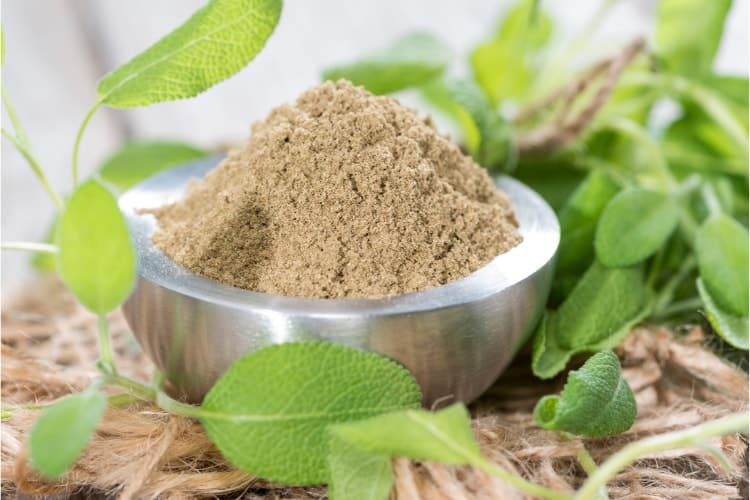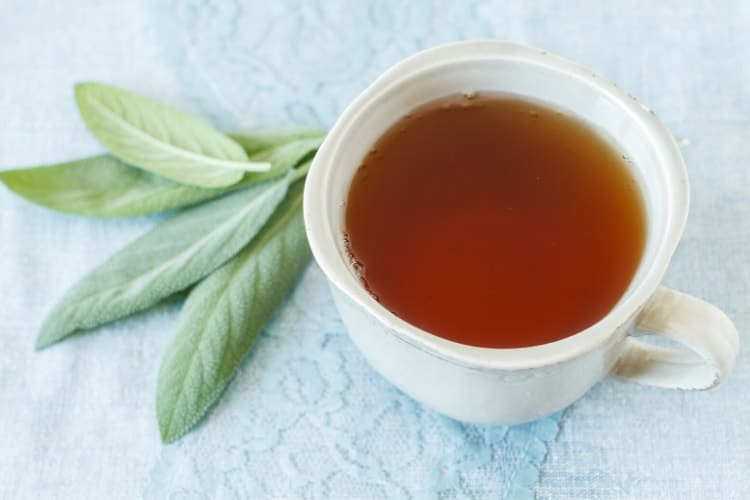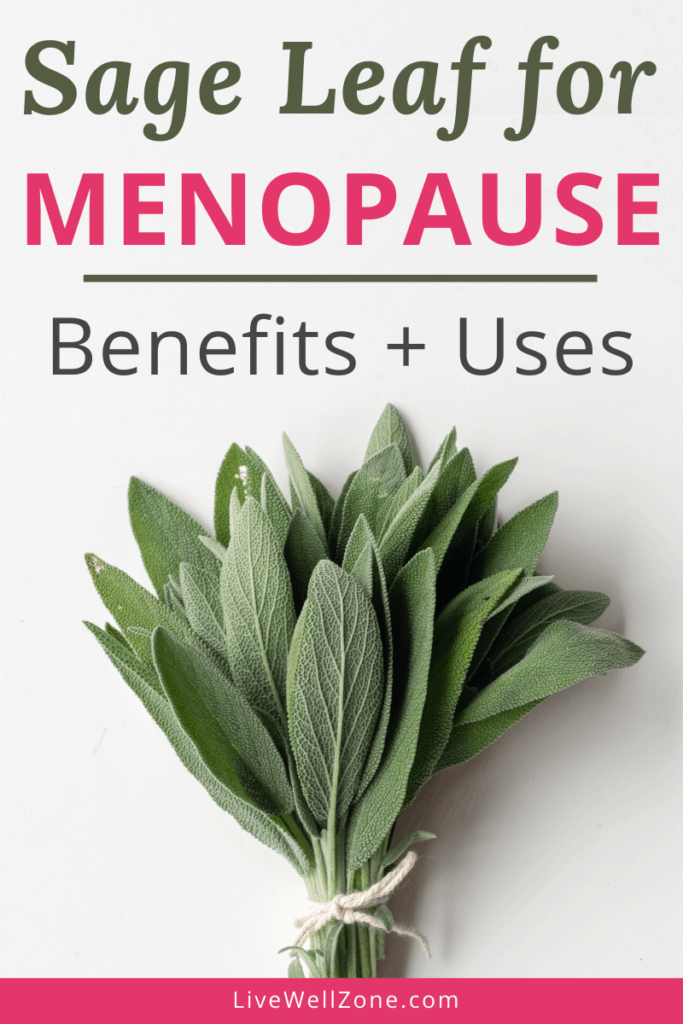
Using sage leaf for menopause is something that often gets overlooked. Yet, this common household herb has a long history of use as a natural remedy for menopause symptoms.
Whether you’re struggling with hot flashes, weight gain, fatigue, night sweats or mood swings, the humble sage leaf has various healing properties that just might give you the relief you’ve been seeking!
Also, it’s interesting to note that sage is actually a member of the mint family. So, there might be something to this family of herbs because peppermint also happens to be quite beneficial during menopause, especially when it comes to hot flashes.
So, if you’d like to learn more about sage leaf and menopause, keep reading because we’re going to look at:
- the key benefits of sage.
- how to make sage tea for menopause.
- the safe dosage of sage tablets.
- safety tips to follow when using sage leaves for menopause.
Note: this post contains affiliate links and I earn a commission (at no additional cost to you) if you use them to make a purchase.
IS SAGE LEAF GOOD FOR MENOPAUSE?
Research done with menopausal women shows that sage is effective at reducing hot flashes. In fact, the more intense the hot flashes are, the more benefit sage seems to provide. In addition, sage contains vitamin K, which can help support bone health during menopause. Furthermore, vitamin K is essential for blood clotting (which can be helpful for heavy bleeding during perimenopause).
Overall, sage has many properties that make it a helpful herbal ally during menopause. Here’s a closer look at the benefits of sage:
1. Natural Remedy for Hot Flashes and Night Sweats
From an herbal perspective, sage is classified as an astringent herb.
And what that means is that sage stabilizes bodily fluids, such as sweat.
In fact, sage is such an effective astringent that in countries like Germany, it’s a government-approved remedy for hyperhidrosis (excessive sweating).
Given this astringent quality, it’s no wonder that sage has historically been used as a natural remedy for both hot flashes and night sweats.
And even though there isn’t a ton of modern research available to validate this historical use, there’s one Swiss study from 2011 that had some very promising results.
In that particular study, 71 menopausal women (who were experiencing at least 5 hot flashes per day) were given 1 sage tablet daily for 8 weeks. After 8 weeks, researchers found that sage leaf led to a decrease in the average number of mild, moderate, severe and very severe hot flashes. The overall reduction in the mean number of hot flashes per day was as follows:
- Mild hot flashes: 46% decrease.
- Moderate hot flashes: 62% decrease.
- Severe hot flashes: 79% decrease.
- Very severe hot flashes: 100% decrease.
2. Supports Bone Health

When it comes to bone health minerals like calcium and magnesium are usually the focus. However, vitamin K, which is found in sage leaf, is also essential for bone health (source).
You see, vitamin K’s job is to activate a protein called osteocalcin.
And osteocalcin’s job is to make sure that calcium is transported to your bones.
So, basically you can eat or supplement calcium…but if you don’t have enough vitamin K in your diet, that calcium won’t make it to your bones.
Now, the good news is that just 1 teaspoon of ground sage contains 10% of the RDI (Recommended Daily Intake) of vitamin K.
So, you can use sage (especially in the form of a tea) as a regular source of vitamin K in your menopause diet.
(By the way, another herb that is a good source of vitamin k is nettle. Learn more about it in this post on the benefits of nettle for hormones).
3. Might Be Helpful for Heavy Perimenopause Bleeding
As I explained in this post on estrogen dominance during perimenopause, many women experience heavy bleeding as they transition into menopause.
And sage can help to reduce that excessive blood loss because it contains vitamin K.
So what’s the link between vitamin K and heavy periods?
Well, the body uses vitamin K for blood clotting.
And whenever we’re losing a lot of blood from any part of the body, blood clotting is an essential first step for curbing that heavy flow.
4. Natural Anti-Inflammatory Herb
Our body’s natural inflammatory process is designed to release cortisol whenever we’re facing stress, such as:
- Chemical stress (from unhealthy food ingredients, pesticides, synthetic hormones and other toxins).
- Emotional stress.
- Physical stress (such as an injured body part).
Unfortunately, when we’re experiencing lots of stress (of any type) that cortisol release can stay chronically elevated.
And that means the inflammatory process stays “ON” all the time.
Once that inflammation becomes chronic this can lead to symptoms like hot flashes, weight gain, vaginal dryness, and more.
So, one of the most beneficial things you can do for your menopause diet is to use an anti-inflammatory herb like sage.
Whether you cook with it, drink it as a tea or take it as a supplement, sage leaf contains lots of antioxidants that protect you from the damaging effects of inflammation.
As a matter fact, research shows that drinking approximately 2 cups of sage tea every day leads to a significant increase in the body’s antioxidant activity (source)!
5. Regulates Blood Sugar and Improves Insulin Sensitivity
If you’re having difficulty losing weight during menopause, then sage leaf might help.
You see, one human study showed that sage extract lowers blood sugar and improves insulin sensitivity (source). In fact, sage was comparable to rosiglitazone, which is diabetes prevention drug that works as an insulin sensitizer.
Furthermore, an animal study also indicates that tea infusions of sage are as effective as the diabetes drug metformin (source).
Now, what does all this have to do with weight struggles during menopause?
Well first, if you happen to be under a lot of stress, then your cells are more likely to become insulin resistant.
This is because during times of stress, your body needs more glucose in the blood as a source of energy.
Secondly, the combination of insulin resistance and stress eventually triggers the body to store more fat (especially in the abdominal area).
Thirdly, when your cells are insulin resistant, that means they’re not being “fed” enough glucose. So, to compensate for the reduction in glucose supply, your body can actually kick up your appetite. You end up eating more because at a cellular level, your body is starving (not enough glucose).
As you can see, everything is connected and it’s very easy to get caught in a vicious cycle that leads to weight struggles.
So, by adding an herb like sage into your menopause diet, you can help your body to potentially break this cycle.
6. Boosts Memory and Mood
Throughout history various species of sage have been used as remedies for depression, memory disorders and other issues related to cognitive function.
In fact, the common sage that is available in the U.S. and many parts of the West has been shown to improve both memory and brain function.
Furthermore, studies show that at higher doses, common sage also increases our sense of calm, alertness and overall feelings of satisfaction.
Given that mood swings and brain fog occur during perimenopause and menopause, sage could be just what you to soothe those symptoms.
7. Supports Estrogen Levels
Similar to other menopause herbs like red clover and black cohosh, studies suggest that sage has estrogen-like properties.
In fact, one study done with postmenopausal women showed that sage supplements produce a statistically significant increase in estradiol levels (source).
So, if you’re looking for a natural way to support estrogen during menopause, consider adding sage to your diet.
HOW TO MAKE SAGE TEA FOR HOT FLASHES AND OTHER MENOPAUSE SYMPTOMS

In order to make your own sage tea, you can either use tea bags or loose leaf tea.
Tea bags provide the most convenience and if you choose to go that route, I recommend using these sage tea bags for your menopause tea.
On the other hand if you’d like to use loose leaf tea, then you can get it from a bulk retailer like Starwest Botanicals. Here’s a link to their sage on Amazon.
Now, when it comes to how much sage tea to drink for menopause, 1 cup a day just might be all you need.
This is based on information from Dr. Tierarona Low Dog (one of my favorite natural health experts).
Dr. Tierarona explains that sage is “supremely effective” for night sweats and recommends drinking just 1 cup in the evening to reduce night sweats and improve sleep (source).
Ingredients
1 tsp dried sage leaf (or 1 tbsp fresh sage)
1 cup boiling water
Instructions
- Pour boiling water over the sage leaves.
- Cover and allow to steep for up to 15 minutes.
HOW TO TAKE SAGE TABLETS FOR MENOPAUSE RELIEF
The studies that I referenced in this article don’t give a clear indication of how much sage was used.
However, I was able to find information (again, from Dr. Tierarona) stating that for the treatment of excessive sweating, 1000mg capsules, twice a day is ideal.
So, you can use that as a starting point.
If you need help finding a good brand of sage supplements, try these sage tablets. They happen to be specifically formulated for menopause.
PRECAUTIONS AND SIDE EFFECTS OF USING SAGE HERB FOR MENOPAUSE
While you can ingest sage in the form of a tea or supplement, you should never ingest the essential oil. Not even in small amounts.
This is because the essential oil is very concentrated and has very high amounts of a compound known as thujone.
In high amounts thujone can damage the nervous system, causing seizures and convulsions (source).
Also, pregnant women should always stay away from sage oil and tea (though they can still use it as a culinary herb).
In addition, since sage regulates blood sugar, it’s best to check with your doctor before combining it with other other drugs that affect blood sugar levels.
Lastly, sage can have a sedative effect on some people. So, if you’re taking other drugs or herbs that have a sedative effect, be sure to check with your doctor before adding sage to the mix.
FAQs ABOUT SAGE LEAF FOR MENOPAUSE
How can I stop hot flashes during menopause?
Aside from sage, hibiscus is another herb that helps a lot with hot flashes. In addition, clary sage and peppermint essential oils are great for getting quick relief from hot flashes.
To learn more about all of these remedies read this post on hibiscus tea and menopause, as well as this collection of essential oil spray recipes for hot flashes.
How can I survive menopause without hormones?
In order to support your hormones naturally during menopause, it’s best to have an anti-inflammatory diet, hormone-balancing herbs and lifestyle habits that support your hormones.
To get started, be sure to read this guide on how to go through menopause naturally.
That post outlines 7 steps that you can use to reset your hormones and experience more ease in your life.

CONCLUSION
Like so many culinary herbs, sage leaf has a wide spectrum of estrogen-balancing and anti-inflammatory properties that make it a worthy natural ally during menopause.
And by combining it with a menopause-friendly diet, sage can help you transition into and out of menopause more comfortably.
Hopefully this post has sparked some new ideas for you!
Related Posts:
Menopause Smoothie: Best Ingredients To Use For Relief (+ Recipes)
Hot Flashes No More: Top 10 Menopause Supplements for True Relief
Essential Oils for Menopause: 11 Best Oils For Relief and How To Use Them
Herbs for Menopause Weight Gain (+ Best Supplement Recommendations)

